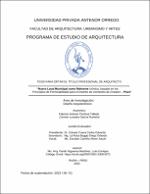| dc.contributor.advisor | Pardo Figueroa Martínez, Luis Enrique | |
| dc.contributor.author | Córdova Talledo, Fabrizio Antonio | |
| dc.contributor.author | García Rumiche, Carmen Lourdes | |
| dc.creator | Córdova Talledo, Fabrizio Antonio | |
| dc.date.accessioned | 2023-11-30T14:39:49Z | |
| dc.date.available | 2023-11-30T14:39:49Z | |
| dc.date.issued | 2023 | |
| dc.identifier.uri | https://hdl.handle.net/20.500.12759/13131 | |
| dc.description.abstract | El Distrito de Veintiséis de Octubre, se conforma por 136 poblaciones entre asentamientos humanos y posesiones informales con 192 701 habitantes. Inicialmente era un sector que pertenecía al distrito de Piura, pero, debido a la desatención de parte de esta la Municipalidad Provincial de Piura (MPP) hacia las necesidades y carencias de la población, este distrito se independizó con la Ley 29991 en el año 2013. Desde sus inicios en la década de 1960, este sector se fue formando con una serie de barriadas contiguas a la Av. Grau y Circunvalación, ocupadas principalmente por migrantes altoandinos. A partir de ese momento creció de manera horizontal, dispersa e informal con asentamientos humanos desprovistos de servicios básicos, equipamientos, obras viales, etc. los cuales se fueron dando de forma muy lenta en el tiempo, evidenciando el abandono de las autoridades de turno y a la vez generando una imagen degradada de este sector. Inicialmente el local municipal funcionó en una vivienda alquilada y provisionalmente adaptada para albergar oficinas en condiciones mínimas para el desarrollo de las actividades municipales según el RNE, lo que impedía ofrecer un servicio de calidad a su distrito. En el año 2019 la MPP cede a Veintiséis de Octubre el terreno que contenía las instalaciones del albergue “Hogar de Cristo”, las cuales fueron adaptadas para el funcionamiento del local municipal, dándose los mismos problemas que el anterior local. Además, este local no presenta características de permeabilidad física para la población.
Nuestro proyecto, a través del estudio y análisis de la problemática identificada en las carencias físicas, funcionales, formales y de relación con su contexto del local municipal, pretende brindar una solución a dicha problemática y convertirse en un referente icónico para el distrito de Veintiséis de Octubre. | es_PE |
| dc.description.abstract | The District of Veintiséis de Octubre is made up of 136 populations, including human settlements and informal settlements, with a total population of 192,701. Initially, this area belonged to the district of Piura, but due to the lack of attention from the Municipalidad Provincial de Piura (MPP) towards the needs and deficiencies of the population, this district became independent with Law 29991 in 2013. Since its beginnings in the 1960s, this sector was formed with a series of contiguous shantytowns along Av. Grau and Circunvalación, mainly occupied by highland migrants. From that moment on, it grew in a horizontal, scattered and informal manner with human settlements lacking basic services, facilities, road works, etc., which were provided very slowly over time, showing the neglect of the authorities and at the same time generating a degraded image of this sector. Initially, the municipal office operated in a rented house that was temporarily adapted to accommodate offices in minimal conditions for the development of municipal activities according to the RNE, which prevented the provision of a quality service to the district. In 2019, the MPP gave Veintiséis de Octubre the land that contained the facilities of the ““Hogar de Cristo““ shelter, which were adapted for the operation of the municipal office, but the same problems persisted as with the previous office. In addition, this office does not have physical permeability characteristics for the population.
Our project, through the study and analysis of the identified problems in the physical, functional, formal, and contextual relationship deficiencies of the municipal office, aims to provide a solution to these issues and become an iconic reference for the District of Veintiséis de Octubre | es_PE |
| dc.description.uri | Tesis | es_PE |
| dc.format | application/pdf | |
| dc.language.iso | spa | es_PE |
| dc.publisher | Universidad Privada Antenor Orrego | es_PE |
| dc.relation.ispartofseries | MEM_ARQ_090 | |
| dc.rights | info:eu-repo/semantics/openAccess | es_PE |
| dc.rights.uri | https://creativecommons.org/licenses/by/4.0/ | es_PE |
| dc.source | Universidad Privada Antenor Orrego | es_PE |
| dc.source | Repositorio Institucional - UPAO | es_PE |
| dc.subject | Local Municipal | es_PE |
| dc.subject | Permeabilidad Fisica | es_PE |
| dc.title | Nuevo Local Municipal como Referente Icónico, basado en los Principios de Permeabilidad para el Distrito de Veintiséis de Octubre – Piura | es_PE |
| dc.type | info:eu-repo/semantics/bachelorThesis | es_PE |
| thesis.degree.level | Titulo Profesional | |
| thesis.degree.grantor | Universidad Privada Antenor Orrego - Facultad de Arquitectura, Urbanismo y Artes | es_PE |
| thesis.degree.name | Arquitecto | es_PE |
| thesis.degree.discipline | Arquitectura | es_PE |
| dc.subject.ocde | http://purl.org/pe-repo/ocde/ford#6.04.08 | es_PE |
| renati.advisor.orcid | https://orcid.org/0000-0001-5308-6571 | es_PE |
| renati.author.dni | 75875915 | |
| renati.author.dni | 71860061 | |
| renati.advisor.dni | 07566268 | |
| renati.type | http://purl.org/pe-repo/renati/type#tesis | es_PE |
| renati.level | http://purl.org/pe-repo/renati/level#tituloProfesional | es_PE |
| renati.discipline | 731176 | es_PE |
| renati.juror | Zulueta Cueva Carlos Eduardo | |
| renati.juror | La Rosa Boggio Diego Orlando | |
| renati.juror | Escobar Carreño Abner Josué. | |
| dc.publisher.country | PE | es_PE |





